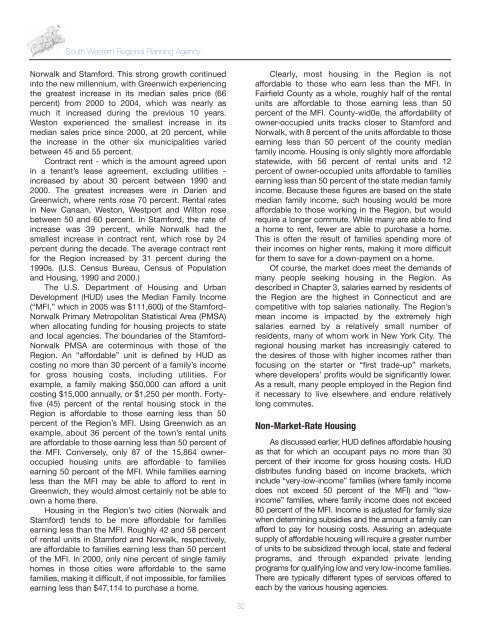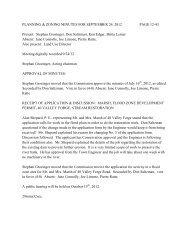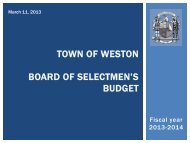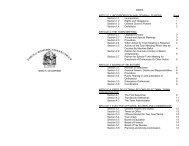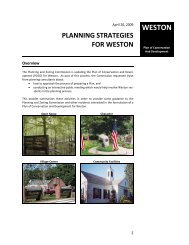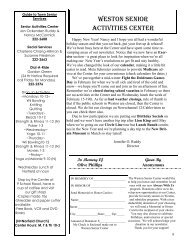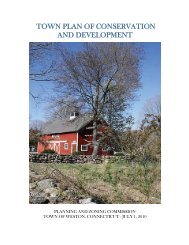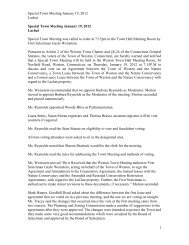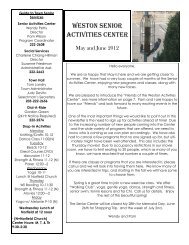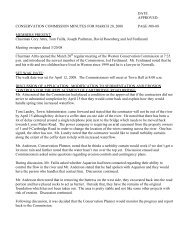Regional Plan of Conservation and Development, 2006-2015
Regional Plan of Conservation and Development, 2006-2015
Regional Plan of Conservation and Development, 2006-2015
You also want an ePaper? Increase the reach of your titles
YUMPU automatically turns print PDFs into web optimized ePapers that Google loves.
South Western <strong>Regional</strong> <strong>Plan</strong>ning AgencyNorwalk <strong>and</strong> Stamford. This strong growth continuedinto the new millennium, with Greenwich experiencingthe greatest increase in its median sales price (66percent) from 2000 to 2004, which was nearly asmuch it increased during the previous 10 years.Weston experienced the smallest increase in itsmedian sales price since 2000, at 20 percent, whilethe increase in the other six municipalities variedbetween 45 <strong>and</strong> 55 percent.Contract rent - which is the amount agreed uponin a tenant’s lease agreement, excluding utilities -increased by about 30 percent between 1990 <strong>and</strong>2000. The greatest increases were in Darien <strong>and</strong>Greenwich, where rents rose 70 percent. Rental ratesin New Canaan, Weston, Westport <strong>and</strong> Wilton rosebetween 50 <strong>and</strong> 60 percent. In Stamford, the rate <strong>of</strong>increase was 39 percent, while Norwalk had thesmallest increase in contract rent, which rose by 24percent during the decade. The average contract rentfor the Region increased by 31 percent during the1990s. (U.S. Census Bureau, Census <strong>of</strong> Population<strong>and</strong> Housing, 1990 <strong>and</strong> 2000.)The U.S. Department <strong>of</strong> Housing <strong>and</strong> Urban<strong>Development</strong> (HUD) uses the Median Family Income(“MFI,” which in 2005 was $111,600) <strong>of</strong> the Stamford-Norwalk Primary Metropolitan Statistical Area (PMSA)when allocating funding for housing projects to state<strong>and</strong> local agencies. The boundaries <strong>of</strong> the Stamford-Norwalk PMSA are coterminous with those <strong>of</strong> theRegion. An “affordable” unit is defined by HUD ascosting no more than 30 percent <strong>of</strong> a family’s incomefor gross housing costs, including utilities. Forexample, a family making $50,000 can afford a unitcosting $15,000 annually, or $1,250 per month. Fortyfive(45) percent <strong>of</strong> the rental housing stock in theRegion is affordable to those earning less than 50percent <strong>of</strong> the Region’s MFI. Using Greenwich as anexample, about 36 percent <strong>of</strong> the town’s rental unitsare affordable to those earning less than 50 percent <strong>of</strong>the MFI. Conversely, only 87 <strong>of</strong> the 15,864 owneroccupiedhousing units are affordable to familiesearning 50 percent <strong>of</strong> the MFI. While families earningless than the MFI may be able to afford to rent inGreenwich, they would almost certainly not be able toown a home there.Housing in the Region’s two cities (Norwalk <strong>and</strong>Stamford) tends to be more affordable for familiesearning less than the MFI. Roughly 42 <strong>and</strong> 58 percent<strong>of</strong> rental units in Stamford <strong>and</strong> Norwalk, respectively,are affordable to families earning less than 50 percent<strong>of</strong> the MFI. In 2000, only nine percent <strong>of</strong> single familyhomes in those cities were affordable to the samefamilies, making it difficult, if not impossible, for familiesearning less than $47,114 to purchase a home.Clearly, most housing in the Region is notaffordable to those who earn less than the MFI. InFairfield County as a whole, roughly half <strong>of</strong> the rentalunits are affordable to those earning less than 50percent <strong>of</strong> the MFI. County-wid0e, the affordability <strong>of</strong>owner-occupied units tracks closer to Stamford <strong>and</strong>Norwalk, with 8 percent <strong>of</strong> the units affordable to thoseearning less than 50 percent <strong>of</strong> the county medianfamily income. Housing is only slightly more affordablestatewide, with 56 percent <strong>of</strong> rental units <strong>and</strong> 12percent <strong>of</strong> owner-occupied units affordable to familiesearning less than 50 percent <strong>of</strong> the state median familyincome. Because these figures are based on the statemedian family income, such housing would be moreaffordable to those working in the Region, but wouldrequire a longer commute. While many are able to finda home to rent, fewer are able to purchase a home.This is <strong>of</strong>ten the result <strong>of</strong> families spending more <strong>of</strong>their incomes on higher rents, making it more difficultfor them to save for a down-payment on a home.Of course, the market does meet the dem<strong>and</strong>s <strong>of</strong>many people seeking housing in the Region. Asdescribed in Chapter 3, salaries earned by residents <strong>of</strong>the Region are the highest in Connecticut <strong>and</strong> arecompetitive with top salaries nationally. The Region’smean income is impacted by the extremely highsalaries earned by a relatively small number <strong>of</strong>residents, many <strong>of</strong> whom work in New York City. Theregional housing market has increasingly catered tothe desires <strong>of</strong> those with higher incomes rather thanfocusing on the starter or “first trade-up” markets,where developers’ pr<strong>of</strong>its would be significantly lower.As a result, many people employed in the Region findit necessary to live elsewhere <strong>and</strong> endure relativelylong commutes.Non-Market-Rate HousingAs discussed earlier, HUD defines affordable housingas that for which an occupant pays no more than 30percent <strong>of</strong> their income for gross housing costs. HUDdistributes funding based on income brackets, whichinclude “very-low-income” families (where family incomedoes not exceed 50 percent <strong>of</strong> the MFI) <strong>and</strong> “lowincome”families, where family income does not exceed80 percent <strong>of</strong> the MFI. Income is adjusted for family sizewhen determining subsidies <strong>and</strong> the amount a family canafford to pay for housing costs. Assuring an adequatesupply <strong>of</strong> affordable housing will require a greater number<strong>of</strong> units to be subsidized through local, state <strong>and</strong> federalprograms, <strong>and</strong> through exp<strong>and</strong>ed private lendingprograms for qualifying low <strong>and</strong> very low-income families.There are typically different types <strong>of</strong> services <strong>of</strong>fered toeach by the various housing agencies.32


